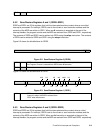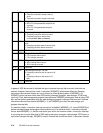
Fixed-Point Interrupts and Exceptions 5-13
occurred; the other ESR bits are set or cleared to indicate the other interrupt. These scenarios are
summarized in Table 5-3
Engineering Note: An implementation can use additional ESR bits to identify implementation-
specific exception types. Implementations can also use the ESR to record information about the
cause of a machine check interrupt.
5.5.6 Data Exception Address Register (DEAR)
The DEAR is a 32-bit register that contains the address of the access for which one of the following
synchronous precise errors occurred: alignment error, data TLB miss, or data storage interrupt.
The contents of the DEAR can be written to a GPR using the mfspr instruction. The contents of a
GPR can be written to the DEAR using the mtspr instruction.
Figure 5-8 shows the DEAR bit definitions.
5.6 Critical Input Interrupts
An external source requests a critical interrupt by driving the critical interrupt input active. The critical
interrupt is recognized if enabled by MSR[CE].
MSR[CE] also enables the watchdog timer first-time-out interrupt. However, the watchdog interrupt
has a different interrupt vector than the critical pin interrupt. See “Watchdog Timer Interrupt” on
page 5-24.
After detecting a critical interrupt, if no synchronous precise interrupts are outstanding, the PPC405
immediately takes the critical interrupt and writes the address of the next instruction to be executed in
Table 5-3. ESR Alteration by Various Interrupts
Scenario ECR[MCI] ESR
4:7, 1213
ESR
8:9, 16
Program interrupt Unchanged Set to type Cleared
Data storage interrupt Unchanged Cleared Set to Type
Data TLB miss interrupt Unchanged Cleared Cleared
Machine check—instruction Set to 1 Cleared Cleared
Disabled MCI, no others Unchanged Unchanged Unchanged
Disabled MCI and program interrupt Unchanged Set to type Cleared
Figure 5-8. Data Exception Address Register (DEAR)
0:31 Address of Data Error (synchronous)
0 31


















